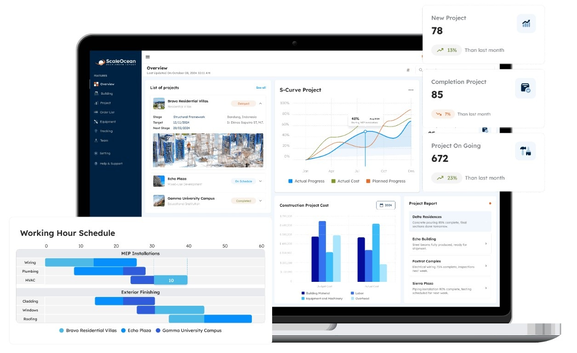A Schedule of Rates (SOR) is a valuable tool used in industries such as construction, manufacturing, and services to standardise pricing for tasks, services, and materials. By having fixed rates, organizations assure consistency in cost computations, giving openness in budgeting and invoicing. This method enables businesses to manage resources more efficiently, reduce disputes, and maintain clear communication with clients and suppliers. In competitive markets like Singapore, where project needs change quickly, a well-structured SOR offers a clear foundation for cost management.
According to Onsite, these rates are often established by government agencies or engineering departments and serve as a guideline for predicting construction project expenses.In this post, we’ll look at the Schedule of Rates’ purpose and benefits, as well as how firms use it for budgeting, billing, and project management. We will also explain the benefits it provides, its essential components, and compare it to the Bill of Quantities to illustrate its role. Furthermore, we will examine real-world examples from various industries and address the issues that firms may experience while implementing a SOR, providing insights into how these can be effectively managed.
- A Schedule of Rates (SOR) is a structured pricing document used to establish set rates for specific services or products.
- Companies utilize the Schedule of Rates to predict costs, create realistic budgets, simplify billing, and improve resource allocation throughout a project.
- The advantages of using a Schedule of Rates include improved expense control, transparency, effective contract management, adaptability, and standardization.
- ScaleOcean Construction Software helps manage the Schedule of Rates effectively by automating cost estimation, budgeting, billing, and project tracking, ensuring real-time updates and transparency.

1. What is the Schedule of Rates?
A Schedule of Rates (SOR) is a structured pricing document that is used across sectors to establish set rates for specific services or products. It functions as a standardized price guide, providing a clear foundation for firms to calculate costs for tasks, labor, and supplies. With the help of the best construction estimating software, this approach provides consistency, transparency, and justice in cost estimation and billing, making it an invaluable tool for businesses in the construction, procurement, and service industries.
Typically, the SOR is used for projects or ongoing services, allowing firms to better manage expenses. It streamlines procurement and contracting by pre-setting pricing, eliminating the need for ongoing negotiations or price modifications. A Schedule of Rates allows businesses to streamline their financial procedures, eliminate unexpected charges, and maintain a consistent price structure across multiple projects or services.
2. What is the Purpose of the Schedule of Rates?
The fundamental goal of a Schedule of Rates is to standardize pricing for goods and services, thereby giving a clear and consistent framework for cost estimation. Setting fixed pricing for activities, materials, and labor helps to reduce uncertainties and ensures that all project participants have a common knowledge of the financial issues. This decreases the possibility of misunderstandings and problems during the project.
According to Designing Buildings, on projects longer than around 18 months, there might be escalation provisions based on annual percentage increases. Furthermore, the timeline improves the effectiveness of procurement operations, making it easier to budget, manage costs, and control spending at various stages of a project. It allows organizations to better plan and manage resources, assuring financial transparency and smoother interactions with clients, contractors, and suppliers.
3. How Do Companies Utilize the Schedule of Rates?
Companies use the schedule of rates to accurately predict costs and create realistic project budgets. Businesses that have predetermined tariffs for specific services and products can plan their expenditures ahead of time, ensuring they stay within budget. This proactive strategy reduces financial uncertainty and establishes the groundwork for successful cost control throughout the project’s life cycle. By integrating Singapore construction cost management software, companies can streamline this process and enhance accuracy in cost predictions and budgeting.
In addition to assisting with budgeting, the schedule of rates simplifies the billing process by offering a clear and uniform mechanism for billing clients. This regularity not only ensures that firms can generate accurate bills, but it also contributes to a continuous cash flow. Predefined rates allow firms to rapidly align their invoices with the actual job accomplished, decreasing time spent on difficult computations and enhancing overall financial management.
Companies can better allocate resources and track spending by including a rate schedule into their project management methods. The clear financial structure offered by the rates guarantees that expenditure is in line with the budget, improving the capacity to achieve project timelines and costs. This kind of insight enables project managers to keep things on schedule and guarantees that financial supervision remains a top priority throughout the project.
Furthermore, rate schedules are critical to regulatory compliance. Standardizing pricing and invoicing methods allows organizations to comply with industry regulations, lowering the chance of legal disputes or financial fines. This transparency is especially important in industries with strong contractual or regulatory frameworks, as it ensures that organizations operate ethically and meet all compliance requirements while keeping clear and consistent pricing systems.
4. What Are the Advantages of Using a Schedule of Rates?

Using a rate schedule has various benefits for businesses, including streamlining processes, improving financial control, and reducing risks. This structured pricing strategy improves the clarity, speed, and consistency of numerous business operations, ensuring that service providers and clients are aligned. Here are the primary advantages of using a schedule of rates:
a. Improved Expense Control
By utilizing a schedule of rates, businesses can gain better control over their expenses. The predefined rates provide a clear breakdown of costs, allowing companies to pinpoint areas where spending can be reduced or optimized. This helps maintain budgets more effectively and avoid unnecessary expenditure during the project.
b. Transparency and Fairness
A well-defined rate schedule fosters fairness among clients and service providers by establishing clear, consistent pricing. This transparency decreases the likelihood of misunderstandings or disputes, resulting in a better, more trusting connection between all parties. It ensures that all parties involved have a thorough awareness of expenses and pricing expectations.
c. Effective Contract Management
Using a schedule of rates simplifies contract management by ensuring that pricing structures are clearly defined from the beginning. It makes it easier to track finished work and outstanding payments, resulting in smoother and more effective contract execution. This also helps to maintain accountability and ensures that all parties follow the agreed-upon terms.
d. Adaptability
A rate schedule is highly adjustable, allowing businesses to quickly adjust to changing market conditions or labor cost fluctuations. This flexibility enables businesses to adjust tariffs as needed without disrupting the project or incurring delays. It guarantees that firms remain flexible to external developments while retaining their price structures in line with market realities.
e. Standardization
Using a rate schedule enables organizations to create regular pricing for services, tasks and materials. This reduces differences between projects, maintaining consistency and equity. Standardized rates allow businesses to better plan expenses, manage resources efficiently, and maintain predictable financial outcomes across multiple projects.
f. Time and Cost Savings
A rate schedule reduces the amount of time spent negotiating prices or reviewing contracts because the rates are predetermined. This facilitates speedier decision-making and project execution, resulting in considerable time and cost savings for enterprises. Furthermore, this streamlined strategy saves administrative workload and speeds up project timelines.
g. Enhanced Quality Control
Companies might use established rates as a benchmark to measure the quality of services and products they get. This ensures that the standards established for each task or product are met, thereby improving the overall quality and consistency of project output. It also gives a clearer structure for quality inspections, making it easier to detect and fix errors quickly.
h. Reduction of Risks
By providing predictable pricing, the rate schedule decreases the likelihood of unanticipated cost overruns or conflicts. This consistency reduces financial and operational risks, giving businesses a clear grasp of their financial obligations and preventing budgetary shocks. Furthermore, it improves risk forecasting, allowing organizations to better prepare for possible issues.

5. Components of a Schedule of Rates
A rate schedule often comprises a full list of services, jobs, or materials, as well as the fees associated with each. This structure allows organizations to understand the cost of each item or job in a project, ensuring consistency and transparency. It covers a wide range of components, including personnel, equipment, and materials, and serves as a comprehensive pricing guide for all essential project tasks.
In addition to these main components, the rate schedule may include payment terms, project timelines, and rate adjustment criteria. These additional features serve to guarantee that all project participants are on the same page about financial terms and timelines. By explicitly identifying these parameters, firms can reduce misunderstandings and improve overall project management efficiency.
6. What Differentiates the Schedule of Rates from the Bill of Quantities?
The Schedule of Rates (SOR) and Bill of Quantities (BOQ) are both important pricing tools, but they differ greatly in form and application. The SOR creates fixed rates for services, labor, and materials, allowing businesses to quickly predict costs and manage project budgets. It provides consistency and simplicity because the prices are predetermined, making it easier to plan and execute projects with predictable pricing.
In contrast, the Bill of Quantities lists all of the materials, labor, and services needed for a specific project. It focuses on the amounts required for each operation or service, allowing businesses to determine overall costs based on actual quantities. The BOQ is more extensive and project-specific, providing a more detailed approach to cost prediction, whereas the SOR is utilized for more uniform pricing across multiple jobs or services.
7. The Example of the Schedule of Rates
The Schedule of Rates is commonly used in a variety of businesses to ensure consistent pricing for services and products. Companies that set established prices can maintain consistency, control costs, and expedite invoicing operations. Here’s how it applies in many sectors:
a. Construction Industry
In construction, a schedule of rates is used to regulate pricing for services such as demolition, excavation, and material acquisition. It guarantees that contractors are fairly billed for finished work, increasing transparency and preventing pricing disputes. This allows contractors to stay within their budget, maintain profitability, and efficiently manage resources, which is crucial for effective construction asset management.
b. Hospitality Industry
Hotels and restaurants utilize rate schedules to unify pricing for services such as cleaning, room service, and catering. It aids in the management of operational costs and the consistency of service, helping organizations to keep costs under control while providing high-quality service. It also makes budgeting easier for seasonal or unpredictable demand.
c. Manufacturing Industry
Manufacturers use a rate schedule to manage the costs of raw materials, labor, and machinery. This is especially beneficial for maintaining consistent price over large-scale manufacturing runs, allowing for precise forecasting and effective resource allocation. Standardization also aids in streamlining production procedures and reducing unexpected expenditures, including factors like salvage value, which can significantly impact long-term financial planning.
d. Healthcare Industry
Hospitals and clinics utilize rate schedules to standardize service pricing, such as consultations, diagnostic testing, and procedures. It streamlines invoicing and assures equitable remuneration for services done, bringing clarity to both patients and healthcare professionals. This structured strategy improves operational efficiency by streamlining payment processes.
Also Read: 15 Construction Site Safety for Singapore Companies
8. What are the Challenges of Using a Schedule of Rates?
While rate schedules have numerous advantages, they sometimes bring obstacles, particularly in industries where project needs change frequently. The rigidity of predefined prices may impede a company’s capacity to respond rapidly to changing needs or unforeseen project demands. As a result, firms may have difficulty meeting new requirements without changing their entire pricing system.
Another problem is the requirement to frequently alter SOR rates to reflect current market conditions. Businesses that do not make these modifications on a consistent basis risk pricing themselves out of profitability or failing to pay rising costs. Furthermore, relying on a rate plan limits a company’s ability to negotiate bespoke pricing for specific projects or clients, thus limiting its competitiveness in a changing market.
9. Manage Schedule of Rates Better with ScaleOcean Construction Software

ScaleOcean Construction Software is a comprehensive cloud-based solution that streamlines project management, improves operational efficiency, and ensures seamless integration for construction companies. This program enables businesses to automate a variety of operations, including cost estimation, budgeting, billing, and project tracking. ScaleOcean enables organizations to easily manage their Schedule of Rates (SOR), assuring uniform pricing, real-time changes, and complete transparency throughout the project lifecycle.
The software’s unique selling characteristics (USPs) include its ability to manage complex projects with simplicity, adaptability to changing market conditions, and scalability to expand with your company. ScaleOcean provides a free demo to enable you to experience the benefits firsthand. You may explore the software’s features and learn how it can revolutionize your project management procedures. Furthermore, ScaleOcean is eligible for the CTC award, making it even more accessible to enterprises wishing to improve their operations. The following are the primary USPs of ScaleOcean software:
- Integrated Budget and Cost Tracking in Real-Time, ScaleOcean enables real-time tracking of project costs and budgets, ensuring that the Schedule of Rates (SOR) is consistently monitored and adhered to, minimizing risks of over budgeting.
- Automated Procurement and Material Scheduling, The system automates material procurement processes, aligning them precisely with the project timeline and SOR, reducing delays caused by manual purchasing and misaligned orders.
- Comprehensive Tender & Bid Management, ScaleOcean’s tender and bid module helps construction companies manage cost estimations and rate submissions accurately and systematically, ensuring competitive and transparent project pricing.
- Smart Contract and Project Management Integration, Contracts and schedules are digitally linked to project execution, enabling proactive updates and adjustments to the SOR when needed, with full visibility across departments.
Also Read: 12 Best ERP Modules for Construction Companies in Singapore
10. Conclusion
The Schedule of Rates (SOR) is a critical instrument that gives organizations a uniform pricing structure for services, materials, and labor. It aids with budgeting, billing, and project management while maintaining compliance and transparency across sectors. However, concerns such as inflexibility and the need for frequent updates must be addressed to guarantee that firms remain profitable and competitive.
ScaleOcean Construction Software provides a strong, scalable solution to address these difficulties and optimize your Schedule of Rates management process. ScaleOcean enables enterprises to improve cost control, transparency, and project management efficiency. To learn more about how ScaleOcean can help you keep ahead of the competition, schedule a free demo now.
FAQ:
1. What is meant by scheduled rates?
Scheduled rates are fixed pricing set for specific jobs, services, or supplies in a variety of industries, including construction and manufacturing. Businesses can use these rates to standardize their cost estimates, allowing for more uniform budgeting, invoicing, and project management.
2. What is the difference between BQ and SoR?
The Bill of Quantities (BQ) details the goods, labor, and services required for a project, whereas the Schedule of Rates (SoR) offers uniform rates for these items. The BQ aids in calculating overall costs depending on quantities, whereas the SoR gives fixed prices for evaluating expenses.
3. What is the meaning of pricing schedule?
A pricing schedule is an orderly list of pre-determined charges for services, products, or tasks that is frequently used in project management and procurement. It guarantees consistency in cost estimates, which helps organizations regulate budgets, manage expenses, and assure financial transparency.
4. What is the schedule of cost?
A cost schedule is a precise breakdown of all project expenses, including labor, materials, and overheads. It helps firms track expenditures, manage budgets, and avoid unexpected financial challenges throughout a project.







 PTE LTD..png)
.png)

.png)








.png)
.png)
















